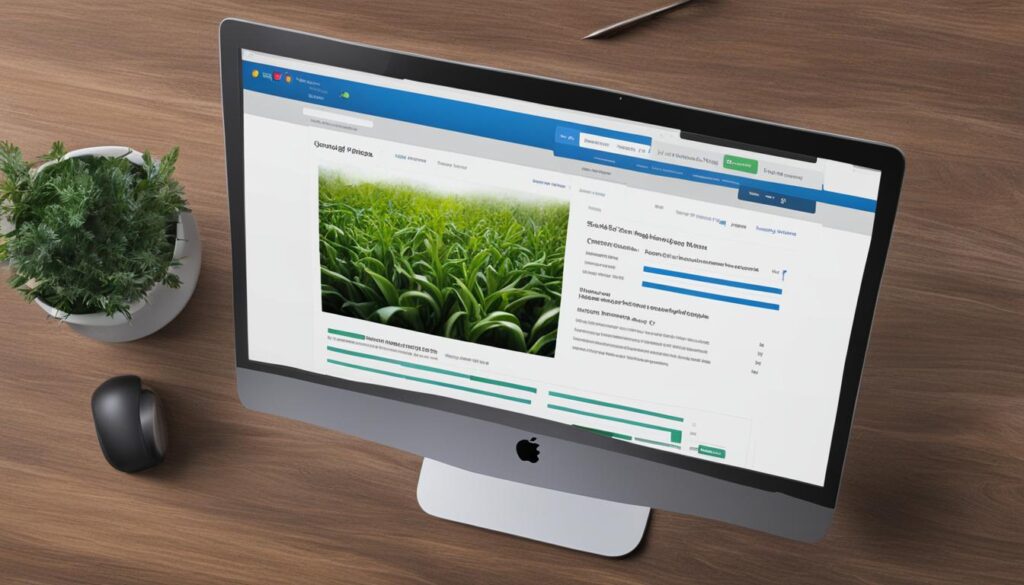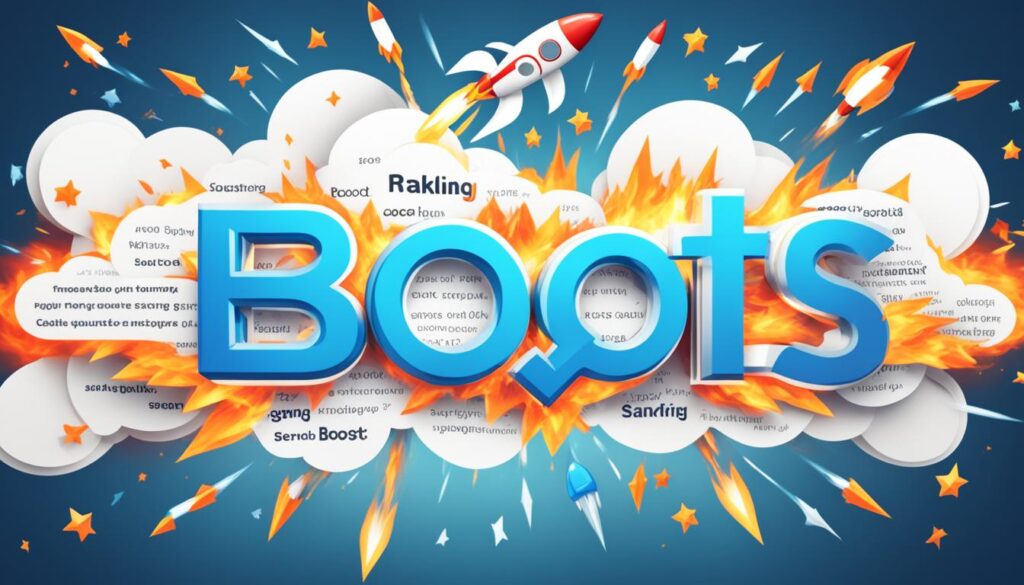Are you struggling to increase your website’s visibility and attract more visitors? Do you want to drive organic traffic and improve your SEO ranking? We have the solution for you! In this article, we will unveil eight effective and free methods to boost your web traffic and attract organic search traffic. Get ready to discover proven strategies that will help you attract more visitors, increase your website traffic, and improve your online visibility.
When it comes to attracting visitors to your website, organic traffic plays a vital role. Unlike paid traffic, organic traffic refers to the visits your website receives from unpaid search results. It not only helps enhance your SEO ranking but also establishes sustainable sources of traffic for your website. Generating organic traffic can be a challenging task, but with the right strategies, you can drive high-quality traffic and increase your website’s visibility.
Key Takeaways:
- Organic traffic refers to the visits a website receives from unpaid search results.
- Boosting organic traffic is essential for improving SEO rankings and increasing online visibility.
- Organic traffic tends to have better conversion rates and establishes long-term sources of traffic.
- In this article, we will explore eight effective and free methods to drive organic traffic to your website.
- Stay tuned and discover the strategies that will help you attract more visitors and increase your website traffic!
Understand the Importance of Organic Traffic
Organic traffic is crucial for the success of a website. Users who search for specific queries on search engines have a clear intent, and if we can provide them with relevant and valuable content, we have the potential to gain new customers. Organic traffic helps build trust and credibility for our website, and it tends to have better conversion rates compared to paid traffic. Increasing organic traffic should be a priority for digital marketers, as it can offer a sustainable source of traffic in the long run.
Prioritize Satisfying Search Intent
Understanding search intent is crucial for driving organic traffic to your website. Search intent refers to the intention behind a user’s search query. By creating content that fulfills the search intent, you can increase your website’s visibility and attract more organic traffic.
One of the key factors in satisfying search intent is conducting keyword research. Keyword research helps you identify the topics and queries that your target audience is searching for. By using tools like Ahrefs, SEMrush, and Moz, you can find relevant keywords and gain insights to develop a content marketing strategy that aligns with user intent.
How to Prioritize Search Intent:
- Identify the main keywords and search queries that are relevant to your website or industry.
- Use keyword research tools to analyze search volume, competition, and user intent.
- Focus on long-tail keywords that are specific to your niche or products.
- Create high-quality content that addresses the needs and questions of your target audience.
- Optimize your content to include relevant keywords and provide valuable information.
Remember, search intent is the driving force behind organic traffic. By understanding what your audience is searching for and creating content that satisfies their needs, you can attract more organic traffic and improve your website’s SEO ranking.
Now, let’s take a look at a real-life example to better understand the importance of search intent. Consider a user searching for “best running shoes for marathon training.” The search intent behind this query is to find recommendations for running shoes specifically for marathon training. If you have a blog post or product page that addresses this query and provides helpful information about the best running shoes for marathon training, you have a higher chance of attracting organic traffic from users who have a genuine interest in your content or products.

By prioritizing search intent and optimizing your content accordingly, you can enhance your website’s visibility, attract more organic traffic, and ultimately drive better results for your business.
Target Keywords Wisely
Keyword targeting is a fundamental strategy for driving organic traffic to your website. While it may be tempting to solely focus on high search volume keywords, it is crucial to choose keywords that are specific to your niche or products. Targeting specific keywords allows you to attract relevant traffic and improve your website’s visibility in search engine results.
One effective approach is to target long-tail keywords. These are more specific keyword phrases that have lower search volume but higher conversion rates. By optimizing your website for long-tail keywords, you can attract visitors who are more likely to engage with your content and convert into customers.
To determine the right keywords for your website, it is essential to conduct thorough research. You can use keyword research tools such as Google Keyword Planner, SEMrush, or Ahrefs to identify relevant keywords with decent search volume. Analyze the competition and search trends to select the keywords that align with your website’s goals and target audience.
Once you have identified your target keywords, be sure to optimize your website accordingly. Place your keywords strategically in your webpage titles, meta descriptions, headers, and throughout your content. However, it is crucial to maintain a natural flow and avoid keyword stuffing, as this can have a negative impact on your website’s ranking.
Here is an example table showcasing the different types of keywords:
| Keyword Type | Example |
|---|---|
| High Search Volume | Organic traffic |
| Specific Keywords | Organic traffic strategies |
| Long-tail Keywords | Effective organic traffic strategies for website growth |
Remember, targeting the right keywords is a critical component of your overall SEO strategy. By optimizing your website for specific keywords, you can improve your organic traffic and attract visitors who are more likely to engage with your content.
Focus on Improving Page Speed
Page speed plays a crucial role in attracting organic traffic to your website. Not only does a slow-loading site result in a poor user experience, but it can also negatively impact your website’s ranking on search engine result pages. In fact, studies have shown that users tend to abandon websites that take more than three seconds to load.
To ensure optimal page speed and enhance user experience, it is essential to focus on website performance. By optimizing your website’s performance, you can improve page speed and attract more organic traffic. One tool that can help in this regard is Largest Contentful Paint (LCP), which measures loading times and identifies areas for improvement.
Why is Page Speed Important?
Improving page speed offers several benefits, including enhanced user experience and increased organic traffic. Here’s why page speed matters:
- Improved user experience: Users expect fast-loading websites and tend to stay longer on sites that load quickly. A smooth and seamless browsing experience encourages visitors to explore your website further and increases the chances of conversion.
- Search engine optimization (SEO) boost: Search engines take page speed into account when ranking websites. Faster sites have a higher chance of appearing in top search results, leading to increased organic traffic.
- Higher user engagement: When users have a positive experience on your website, they are more likely to engage with your content, share it with others, and return for future visits.

“A one-second delay in page load time can result in a 7% reduction in conversions.” – Google Developers
By focusing on improving page speed, you can provide users with a seamless browsing experience, increase organic traffic, and boost your website’s overall performance. Now, let’s explore some actionable steps you can take to optimize page speed and attract more organic traffic to your website.
Repurpose and Refresh Old Content Consistently
Repurposing and refreshing old content is a powerful technique for driving organic traffic. By updating outdated information and improving the quality of your existing content, you can attract new visitors and increase organic traffic. Analyze your website’s data to identify posts that have the potential for improvement and update them with fresh and relevant information. Historical optimization has shown significant increases in organic traffic for many websites. Consistently refreshing and repurposing old content helps maintain its relevance and attract more organic traffic.
One effective strategy to optimize your content is to identify high-performing articles that may be dated but still have potential. By updating the information and providing additional insights, you can make the content more valuable to both search engines and readers. This process involves reviewing the analytics data to identify articles that receive consistent organic traffic but may have outdated information, keywords, or formatting.
For instance, if you have an article that provides tips on social media marketing from a few years ago, you can refresh it by including the latest trends, strategies, and best practices. Additionally, you can optimize the article by incorporating new keywords and improving the overall readability. By doing so, you improve the chances of capturing organic traffic for relevant search queries.
Another approach is to repurpose your content into different formats. If you have a well-performing blog post, consider turning it into a video, infographic, or podcast episode. By leveraging different mediums, you can reach a broader audience and attract more organic traffic. Additionally, repurposing content allows you to explore new distribution channels and tap into different user preferences.
When updating and repurposing old content, don’t forget to optimize it for SEO. Perform keyword research to identify new keywords or long-tail variations that can be incorporated into the refreshed content. Make sure to update the title, meta description, headers, and other on-page elements to align with the target keywords and improve search engine visibility.
Remember, consistently refreshing and repurposing old content is an ongoing process that requires dedication and analysis. Regularly monitor your website’s performance, identify opportunities for improvement, and apply the necessary changes. By doing so, you can tap into the full potential of your existing content and experience significant website traffic growth over time.
Example
“At XYZ Marketing, we understand the value of repurposing and refreshing old content. We recently analyzed our website’s data and identified several articles that were receiving consistent organic traffic but were outdated. By updating the content with the latest information, optimizing it for SEO, and repurposing it into video tutorials, we saw a significant increase in organic traffic and engagement. Repurposing and refreshing old content is a cost-effective way to drive website traffic growth and attract new visitors.” – Sarah Johnson, Content Manager at XYZ Marketing

Optimize Internal Links
Internal links are a vital component of your website’s optimization for driving organic traffic. By strategically linking relevant pages within your website, you can distribute link equity and improve the flow of PageRank. This optimization technique boosts the SEO performance of specific pages and contributes to an increase in organic traffic.
An effective way to optimize internal links is by using tools like Ahrefs Site Audit. These tools help identify internal linking opportunities and provide insights into anchor text and link placement for maximum impact. By implementing an optimized internal linking strategy, you can enhance the visibility of your content and attract more organic traffic to your website.
Benefits of Optimizing Internal Links for Organic Traffic:
- Improves website navigation and user experience
- Distributes link equity and improves PageRank flow
- Boosts the SEO performance of specific pages
- Increases organic traffic and online visibility
Strategically linking relevant pages can also improve keyword rankings and contribute to higher search engine result page (SERP) positions. It helps search engines understand the structure of your website and the relationships between different pages, ultimately leading to better indexing and crawling.
When optimizing internal links, consider the following:
- Anchor text: Use descriptive and relevant anchor text that accurately conveys the content of the destination page.
- Link placement: Position links within the content where they make sense contextually, enhancing the user experience.
- Relevance: Link pages that are related and offer additional value to users, encouraging them to explore further.
- Link depth: Avoid excessive levels of nested links to maintain a clear and concise website structure.
Implementing an optimized internal linking strategy is a proven method to enhance your website’s visibility and drive organic traffic. By carefully crafting and regularly reviewing your internal links, you can improve engagement, increase dwell time, and ultimately boost your website’s SEO performance.

Target People Also Ask Sections
People Also Ask sections in search engine results can be a goldmine for driving organic traffic to your website. These sections display relevant questions and answers related to a search query, offering users quick access to valuable information. By optimizing your content to answer these questions concisely and providing valuable insights, you can increase your chances of appearing in these sections and attract more organic traffic.
Winning a featured snippet in the People Also Ask section is especially beneficial as it can significantly boost your organic traffic. Featured snippets are concise summaries of information displayed above the regular search results, capturing users’ attention and driving increased visibility to your website.
To target People Also Ask sections effectively, it is essential to align your content with user intent and search queries. Start by researching the most common questions in your industry and identify the specific pain points users are seeking to address. Understanding user intent will help you create content that fulfills their needs and attracts organic traffic.
Here are some strategies to optimize your content for People Also Ask sections:
1. Provide comprehensive answers
When crafting your content, make sure to provide in-depth and valuable answers to the questions featured in the People Also Ask section. Focus on addressing the query concisely while adding relevant details that showcase your expertise.
2. Use structured formats
Structured formats such as tables, lists, and bullet points are visually appealing and easy to read. They enhance the user experience and make it more likely for your content to be selected and featured in the People Also Ask section.
3. Implement schema markup
Schema markup is a type of structured data that provides additional information to search engines, helping them understand the context and relevance of your content. Implementing schema markup can increase the chances of your content being displayed in the People Also Ask section.
4. Focus on long-tail keywords
Long-tail keywords are more specific search terms that often comprise three or more words. By targeting long-tail keywords in your content, you can align with the specific questions users are asking in the People Also Ask section and increase your chances of being featured.
Remember, the key to targeting People Also Ask sections successfully is to provide valuable and relevant content that fulfills the user’s search intent. By optimizing your content for these sections, you can attract more organic traffic and establish your website as a trusted source of information in your industry.

| Highlighted Benefits | Strategies to Implement |
|---|---|
| Increase organic traffic | Provide comprehensive answers |
| Enhance visibility on search engine results pages | Use structured formats |
| Establish authority and expertise | Implement schema markup |
| Drive targeted traffic with specific queries | Focus on long-tail keywords |
Translate Content for International Audiences
Expanding your website’s reach to international audiences is a powerful strategy to increase organic traffic. Search engines personalize search results based on users’ language preferences and locations. By translating your top-performing content into different languages, you can effectively cater to a broader audience and attract more organic traffic.
To begin, it’s important to conduct thorough research to identify which languages are relevant to your target audience. Consider factors such as the countries where your products or services are in demand and the languages predominantly used in those regions. By understanding the language preferences of your international audience, you can tailor your content to meet their needs.
Once you have identified the languages to target, it’s time to translate your content effectively. While machine translation tools may seem tempting, it is recommended to opt for professional translation services or work with native speakers to ensure the accuracy and quality of your content in each language. This will help maintain the integrity of your message and effectively engage with your international audience.
Expanding your content to multiple languages not only increases your organic traffic but also improves your website’s visibility on a global scale. By providing valuable information in the languages your audience understands best, you establish a strong connection and build trust with international users. This can result in higher conversion rates and long-term sources of organic traffic for your website.






